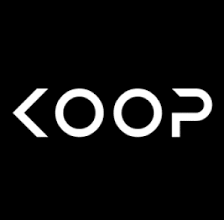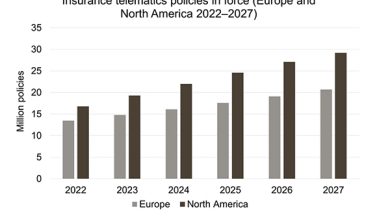Usage based insurance market projected to reach $80.7B by 2028
CHICAGO, Oct. 13, 2023 /PRNewswire/ — Usage Based Insurance Market is projected to grow from an estimated USD 30.6 billion in 2023 to reach USD 80.7 billion by 2028 at a CAGR of 21.4% during the forecast period, according to a new report by MarketsandMarkets™. The usage-based insurance market is estimated to be fueled by growing EV and ICE vehicle sales equipped with embedded telematic systems. These connected cars are equipped with multiple sensors that can gather data on driver behavior, mileage, speed, and braking patterns. This data makes it easier for usage-based insurance companies to devise the premiums. Also, factors such as lower premiums and more personalized coverage are further expected to drive the market for usage-based insurance. It have used cutting-edge technologies such as AI, data science, and blockchain to lower insurance premiums compared to regular automotive insurance. This is also expected to drive the market.
Browse in-depth TOC on “Usage Based Insurance Market“.
178 – Tables
56 – Figures
346 – Pages
Usage Based Insurance Market Scope:
| Report Coverage | Details |
| Market Size | USD 80.7 billion by 2028 |
| Growth Rate | 21.4% of CAGR |
| Largest Market | North America |
| Market Dynamics | Drivers, Restraints, Opportunities & Challenges |
| Forecast Period | 2023-2028 |
| Forecast Units | Value (USD Billion) |
| Report Coverage | Revenue Forecast, Competitive Landscape, Growth Factors, and Trends |
| Segments Covered | By package type, by vehicle type, by vehicle age, by device offering, by electric vehicle, by technology, and by region |
| Geographies Covered | Asia Pacific, North America, Europe, and Rest of the World. |
| Report Highlights | Updated financial information / product portfolio of players |
| Key Market Opportunities | Developing automotive usage-based insurance ecosystem |
| Key Market Drivers | Increasing adoption of telematics and connected cars |
Light Duty Vehicle (LDV) dominates the market by vehicle Type during the forecast period.
The scope defines Light duty vehicles as light commercial Vehicles (LCVs) and passenger cars. LDVs have more adoption of usage-based insurance as compared to HDVs. Connected passenger cars are more than connected commercial vehicles. Most passenger cars nowadays have devices like OBD-II embedded telematics systems or can integrate with smartphones. This can gather all the information regarding driving habits and set the UBI plans. Furthermore, passenger cars are widely used – from daily commutes to occasional leisure trips. With the growing demand for ride-sharing and Mobility-as-a-Service, the need for UBI becomes more intrinsic.
The UBI service providers continue to develop new applications and services for connected cars that enable their use in parking and ride-sharing services. Also, the top key players are offering new UBI products and plan for light-duty vehicles, which are into ride-sharing, rental cars, personal use, and autonomous vehicles. Examples of these products include Drivewise, Drive Safe and Save, RightTrack, Snapshot, SmartRide, and SafePilot. Thus, the LDVs are expected to witness a substantial UBI penetration over the forecast period.
BEVs are the fastest-growing segment in the usage-based insurance market.
Various sensors in Battery electric vehicles (BEVs) generate data about vehicle usage, including speed, mileage, braking patterns, and battery usage. Insurers can use this data to develop more sophisticated UBI programs that reward drivers for safe and efficient driving. BEVs are more predictable than gasoline-powered vehicles regarding their performance and maintenance needs. This makes it easier for insurers to price UBI premiums for BEVs.
The BEVs help insurers attract and retain customers by offering UBI programs. To the younger drivers, particularly those who are more likely to show interest in new technologies and personalized insurance products. According to the International Energy Agency, in 2022, SUVs and more oversized vehicles will dominate the available EV models. These vehicles contribute 60% of the total BEVs available in Europe, the US, and China. Mark Lines reported that global sales reached 6 million new BEVs and PHEVs in the first two-quarters. Hence, these increased sales of BEVs in the US and Europe are driving the usage-based insurance Industry.
Automakers like Tesla (US) offer their own UBI program called ‘Safety Score,’ which rewards Tesla drivers for safe driving habits, such as avoiding hard braking and accelerating, making the premiums for BEVs competitive compared to ICE vehicles. Tesla also uses vehicle data to give drivers insights into their driving behavior. Hence, these new initiatives by BEV manufacturers also drive the UBI market.
North America holds the largest market share for the usage-based insurance market.
North America has a high adoption rate of telematics, devices that collect data about vehicle usage. This data is essential for UBI programs, as it allows insurers to price premiums based on individual driving behavior. In addition, North American consumers are more aware of usage-based insurance, and the UBI acceptance is more in the NA region. Also, the North American insurance industry is quite competitive, where insurers seek innovative ways to attract and retain customers. UBI allows insurers to differentiate themselves and offer more tailored and competitive products.
The North American region holds a significant market share for the growing popularity of MaaS, driving demand for UBI programs. MaaS providers offer various transportation services, such as car sharing and ride-hailing. These services typically use telematics to track vehicle usage, which makes them ideal for UBI programs. OEMs and insurers are increasingly collaborating to offer UBI programs to their customers. For instance, GM and Progressive have partnered since 2015 and continue to provide a UBI program called “SmartDrive” to date. This program rewards GM drivers for safe driving habits, such as avoiding hard braking and speeding. North America has UBI’s top key players: Allstate Insurance Company, Farmers Insurance, Nationwide Mutual Insurance Company, Progressive Casualty Insurance Company, State Farm Mutual Automobile Insurance Company, etc.
Key Market Players:
The usage-based insurance companies in North America, are UnipolSai Assicurazioni S.p.A (Italy), Progressive Casualty Insurance Company (US), Allstate Insurance Company (US), State Farm Automobile Mutual Insurance Company (US), and Liberty Mutual Insurance Company (US).
Recent Developments:
- In June 2023, UnipolSai introduced BeRebel, a new car insurance policy based on the pay-per-use model. BeRebel is the first of its kind in Italy and Europe. It is a monthly, kilometer-based, fully digital car policy. The fixed monthly cost is approximately USD 10.69, which covers 200 km of travel. It charge about 2 cents/km for each additional kilometer driven. It can carry over any unused kilometers to the following month. This policy is based on telematics data, which tracks the kilometers driven and the driving style.
- In February 2022, State Farm Mutual Automobile Insurance Company launched a usage-based insurance (UBI) program that uses data from a vehicle’s telematics system to track driving behavior and mileage. Drivers who exhibit safe driving habits and drive fewer miles can earn discounts on their insurance premiums. In this service, the agent provides a small device that plugs into the vehicle’s diagnostic port where the device will collect data from the vehicle’s telematics system and send it to State Farm.
- Progressive Corporation and Protective Insurance Corporation announced in February 2021 had signed a legally binding agreement in which Progressive agreed to buy all of Protective Insurance Corporation’s outstanding Class A and Class B ordinary shares.
- In July 2021, Unipol’s Linear Assicurazioni and Cambridge Mobile Telematics (CMT) launched Italy’s first try-before-you-buy auto insurance program. The program, called “Drive Smart, Pay Less,” allows drivers to test drive a car insurance policy for 14 days before they commit to buying it. The program uses CMT’s DriveWell telematics platform to track the driver’s behavior. The platform measures speed, acceleration, braking, and cornering to assess the driver’s risk profile.




